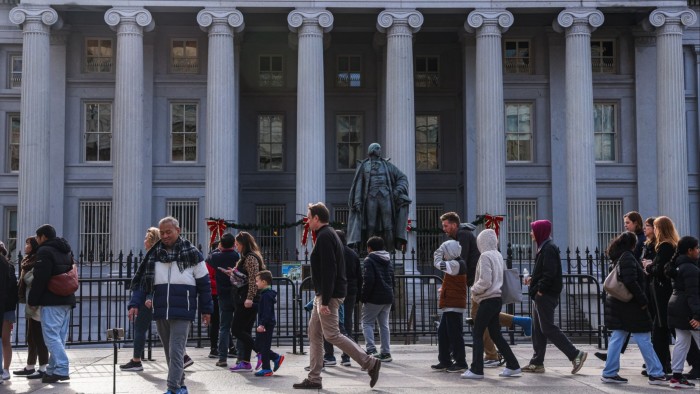Spiralling US public debt risks action from bond vigilantes


Roula Khalaf, Editor of the FT, selects her favourite stories in this weekly newsletter.
Bond vigilantism is resurgent in the market for sovereign debt. That emerged with remorseless clarity from the brutal sell-off of UK gilts that toppled hapless British prime minister Liz Truss. Could the fiscal disciplinarians of the global investment community now turn their disruptive talents to the US Treasury market?
As well as savaging the president of the day, such a challenge could devastate the US’s role as the world’s chief provider of safe assets during global crises, while simultaneously threatening the dollar’s status as the pre-eminent reserve currency.
For many, the idea is simply unimaginable. In a recent speech, Federal Reserve governor Christopher Waller declared that flights to the dollar in the financial crises of 2008 and 2020 were “the ultimate vindication that the US dollar is the world’s reserve currency and is likely to remain so”.
Well, yes. The dollar is, after all, backed by the world’s biggest, most liquid debt market. It enjoys what economists call network externalities: widespread acceptance engendering wider use. Supported by the world’s largest economy, the currency is a magnet for nearly 60 per cent of all central banks’ foreign exchange reserves.
Note, too, that despite the US economy’s shrinking share of global output, the outcome has merely been a genteel decline in the dollar’s relative share of global reserves. That said, governor Waller conspicuously failed to mention the biggest reason for thinking Treasuries are no longer an ultra-safe store of value.
This is not the US’s appallingly dysfunctional politics. Nor the weaponisation of the dollar thanks to geopolitics. Nor again the possible competitive threat from other central banks’ digital currency plans. Rather, it is a spiralling public debt now exceeding 97 per cent of gross domestic product, a level not seen since the second world war.
The parallel with the immediate postwar period is instructive. The US succeeded in reducing the debt-to-GDP ratio from 106 per cent in 1946 to 23 per cent by 1974. But the debt was mainly domestic, whereas today nearly a quarter is in foreign hands. For about half the time to 1980, real interest rates in the advanced economies were negative. Carmen Reinhart and Belen Sbrancia have estimated that for the US and UK the annual liquidation of debt thanks to those negative interest rates averaged 3 per cent to 4 per cent of GDP a year.
That arose from a policy of financial repression involving direct lending by captive investment institutions and banks to government, interest rate caps and capital controls. In the three decades after the war, the growth rate of national output also exceeded the interest rate on government debt for most of the time. Result: phenomenal debt shrinkage.
With today’s global capital flows and deregulated markets financial repression would be unenforceable. The Fed has levered up interest rates to help meet a 2 per cent inflation target and ultra-low interest rates are gone. Meantime, the Congressional Budget Office predicts the US deficit will soar by nearly two-thirds in the next decade, with interest payments accounting for three-quarters of the increase. That stems from the morally hazardous debt binge induced by years of ultra-loose monetary policy.
Even the Treasury has declared the public debt burden unsustainable. That means its own supposedly safe IOUs — the linchpin of global markets — are potentially unsafe. To remedy that would require fiscal consolidation, meaning debt reduction. Some hope in a polarised US, whether under Joe Biden, Donald Trump or whoever.
The demise of dollar dominance has long been predicted, but never happens because other countries cannot match the supposed safety and liquidity of US Treasuries. Yet that logic may fracture in the face of a deep seated problem identified by economists Ethan Ilzetzki, Reinhart and Kenneth Rogoff. They argue the demand for safe dollar debt risks overwhelming the US government’s capacity to back it when the tax base is diminishing. In which case we are in similar territory to the collapse of the Bretton Woods exchange rate regime in the early 1970s, which unleashed two decades of high inflation and enduring financial instability.
It is thus safe to predict that the relative fiscal probity of sovereign borrowers will become a more pressing concern of official reserve managers. And, if the vigilantes strike, the nature of a flight to quality will, in the ensuing firestorm, be redefined as fiscally profligate countries are beset by financial crises. Meantime, fiscal conservatives that generate few safe assets will be hit by uncontrollable bond market bubbles. Policymakers should start contingency planning now.
Comments